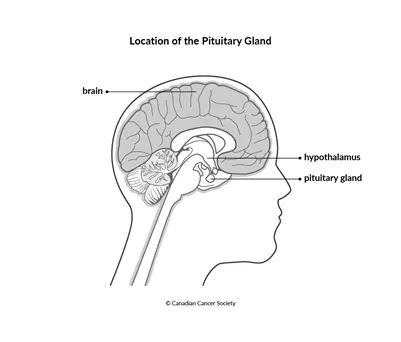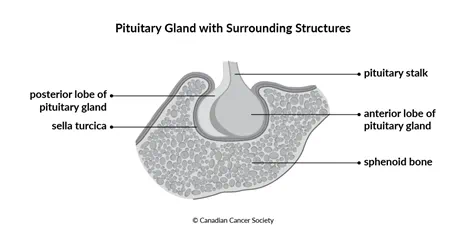The pituitary gland
The pituitary gland is part of the
The pituitary gland is in your head. It sits in the sella turcica, which is a small space surrounded by the sphenoid bone. It’s behind the nasal cavity and just above the sphenoid sinus (a hollow space deep in the skull).
The pituitary gland is connected to a part of the brain called the

The pituitary gland is divided into 2 parts (called lobes). The anterior lobe is the front of the pituitary gland, closer to the face. The posterior lobe is the back of the pituitary gland, closer to the back of the head.

Pituitary gland hormones
The pituitary gland makes 9 different hormones. Both the anterior and posterior lobes of the pituitary gland make hormones.
Anterior pituitary gland hormones
The anterior lobe of the pituitary gland makes the following hormones.
Adrenocorticotropic hormone (ACTH)
tells the adrenal glands to make
Growth hormone promotes the growth of all tissues in the body, including bones and muscles. It allows bones and muscles to grow during childhood. In adults, it helps maintain body tissues. Growth hormone is also called somatotropin.
Thyroid-stimulating hormone (TSH) encourages the thyroid to make and release hormones that control growth, body temperature and heart rate. They are also involved in metabolism, which is the chemical processes in the body that create and use energy. TSH is also called thyrotropin.
Follicle-stimulating hormone (FSH) and luteinizing hormone (LH)
are called
-
FSH and LH tell the ovaries to make
estrogen andprogesterone and to release eggs (ovulation). -
FSH and LH tell the testicles to make
testosterone and sperm.
Prolactin stimulates the breasts to develop and make milk after childbirth. Prolactin is also called lactotropin.
Melanocyte-stimulating hormone (MSH) causes a type of skin cell (called a melanocyte) to make melanin. Melanin is the substance that gives skin its colour and helps protect the body from some of the harmful effects of the sun.
Posterior pituitary gland hormones
The posterior lobe of the pituitary gland stores the following hormones.
Antidiuretic hormone (ADH) balances water and sodium levels in the body. ADH tells your kidneys to hold more water, which lowers the amount of urine your body makes. ADH is also called vasopressin.
Oxytocin
causes the
Your trusted source for accurate cancer information
With support from readers like you, we can continue to provide the highest quality cancer information for over 100 types of cancer.
We’re here to ensure easy access to accurate cancer information for you and the millions of people who visit this website every year. But we can’t do it alone.
Every donation helps fund reliable cancer information, compassionate support services and the most promising research. Please give today because every contribution counts. Thank you.
